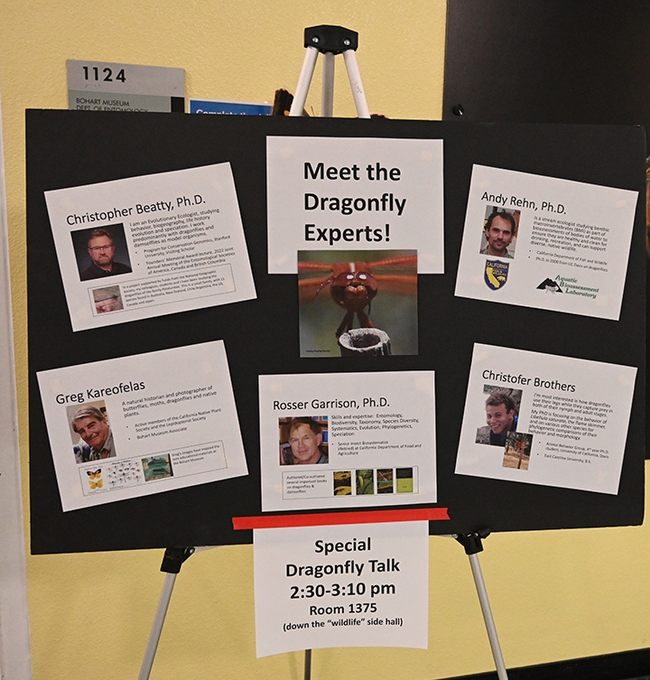
That was the theme of the Bohart Museum of Entomology open house on Sunday afternoon, Nov. 6, and dragonflies do just that--they rule.
They don't just rule in the water as larvae and in the air as adults.
They ruled at the Bohart Museum open house as visitors examined the displayed specimens; admired the images in the displayed books and the slide presentations; and chatted with the dragonfly experts.
A sign, "Meet the Dragonfly Experts," greeted the more than 220 guests:
- Rosser Garrison, retired from the California Department of Food and Agriculture (Pest Diagnostics Branch of Plant Health and Pest Prevention Services)
- Christopher Beatty, a visiting scholar in the Program for Conservation Genomics at Stanford University
- Bohart associate Greg Kareofelas
- UC Davis doctoral student Christofer Brothers of the laboratory of Professor and Chancellor's Fellow Stacey Combes, Department of Neurobiology, Physiology and Behavior, College of Biological Sciences.
- Andy Rehn, stream ecologist with the California Department of Fish and Wildlife and a UC Davis doctoral alumnus
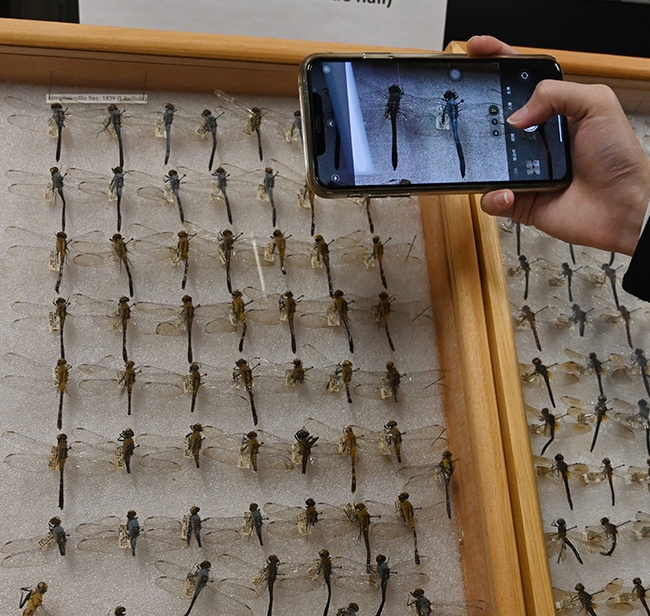
Garrison, widely recognized as one of the current leading experts of the taxonomy of New World Odonata, delivered an hour-long presentation and answered questions. He and his wife, Natalia von Ellenrieder, a senior insect biosystematist with CDFA, have worked intensively with the Odonata fauna of the Neotropical region. He has written more than 100 publications pertaining to Odonata, including three books: Dragonfly Genera of the New World: An Illustrated and Annotated Key to the Anisoptera (2006), Damselfly Genera of the New World: An Illustrated and Annotated Key to the Zygoptera (2010) and, as co-author, Dragonflies of the Yuangas: A Field Guide to the Species from Argentina (2007).
Garrison told the crowd that "There are over 6300 species of dragonflies throughout the world. They are excellent fliers; they hunt by sight and seize their prey (other insects) on the wing. Their size ranges between 2 and 15 centimeters."
Other facts discussed about dragonflies included:
- The larvae are aquatic and they can be carnivores.
- The fossil record is rich.
- Dragonfly relatives existed before the onset of the dinosaurs---Triassic Period, 250 to 200 million years ago
- They have a primitive flight mechanism compared to other insects, bees, butterflies, beetles and flies.
- Dragonflies mostly mate on the wing.
- They are not poisonous and they do not sew up people's ears (“devil's darning needles”). However, one group of large dragonflies are called—appropriately—"Darners."
- Larvae have a prehensile foldable lower lip unique in insects; it is used for capturing prey like mosquito larvae or even small fish.
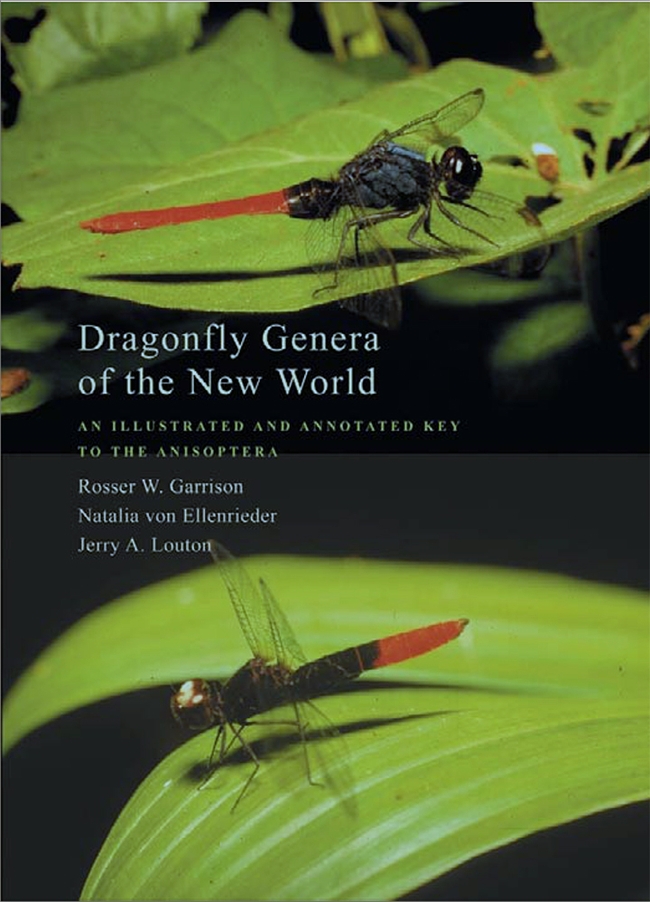
Garrison's publications include descriptions of more than 75 new species and six new genera of Odonata. In the Americas, he has done entomological field work in the United States, Mexico, Costa Rica, Panama, Guyana, French Guiana, Venezuela, Ecuador, Peru, Brazil, Argentina and Chile. He has also collected dragonflies in Australia, Papua New Guinea, China, Thailand, Namibia and Iran. One genus and 10 species of Odonates are named after him.
Christopher Beatty
Christopher Beatty has been working "for a few years on petaltail dragonflies, with much of the work focused on the Black Petaltail (Tanypteryx hageni) in California and Oregon." Beatty was recently selected to present the prestigious Entomological Society of America's Founders' Memorial Lecture at the 2022 Joint Annual Meeting of the Entomological Societies of America, Canada, and British Columbia. He'll speak at the awards breakfast on Nov. 15 on "The Passionate Observer: The Life and Times of Jean-Henri Fabre." Fabre (1823-1915) was a French naturalist, entomologist, educator, and author.
Beatty said he has focused much of his entomological career studying the behavior and ecology of dragonflies and damselflies, having served in research and teaching positions at the University of Vigo (Spain), Santa Clara University, Cornell University, the University of Kiel (Germany), and Stanford University. He has authored or co-authored more than 25 peer-reviewed articles since 2003, and he is co-editor of the newly published Dragonflies & Damselflies: Model Organisms for Ecological and Evolutionary Research, 2nd Edition (Oxford University Press).
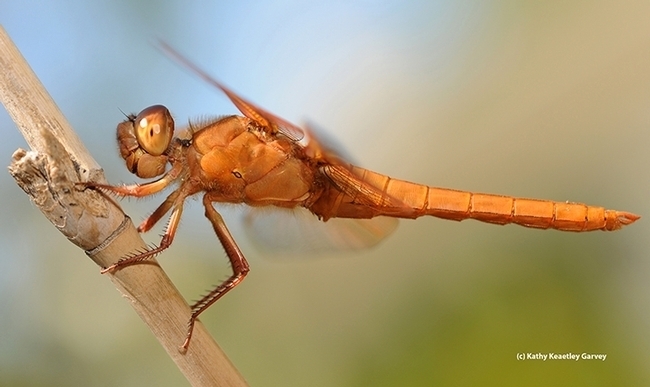
Andy Rehn is a stream ecologist studying benthic macroinvertebrates as part of bioassessments of bodies of water to ensure they are healthy and clean for drinking and recreation and can support diverse, native wildlife. He received his doctorate, studying dragonflies, at UC Davis in 2000.
Christofer Brothers
Cristofer Brothers is a fourth-year animal behavior doctoral student. He is researching how dragonflies, in both their nymph and adult stages, use their legs to capture prey. In particular, he studies the behavior of the flameskimmer, Libellula saturata. Brothers delivered a guest presentation on dragonfly predation behavior at the 2022 UC Davis Bio Boot Camp.
Greg Kareofelas
Greg Kareofelas credits Andy Rehn with inspiring him to study dragonflies. "That was when Andy was a doctoral student at UC Davis." Kareofelas, a longtime Bohart associate, naturalist and insect photographer, assists at Bohart events and presents informational talks at the Bohart Museum lab meetings, among other venues. He most recently gave a presentation on dragonflies at the Nov. 4th lab meeting. His work includes providing images for the poster, "Dragonflies of California," available in the Bohart Museum gift shop. Entomologist Fran Keller, a professor at Folsom Lake College and a UC Davis doctoral alumnus, designed the poster.
The Bohart Museum, founded in 1946, is located in Room 1124 of the Academic Surge Building, 455 Crocker Lane, UC Davis campus. Directed by Lynn Kimsey, UC Davis distinguished professor of entomology, it is the global home of eight million insect specimens, as well as the live "petting zoo" and an insect-themed gift shop stocked with t-shirts, hoodies, books, posters, jewelry, collecting equipment and more. Named for UC Davis professor and noted entomologist Richard Bohart, it is open to the public from 8 a.m. to noon, and 1 to 5 p.m., Mondays through Thursdays.
Attached Images:
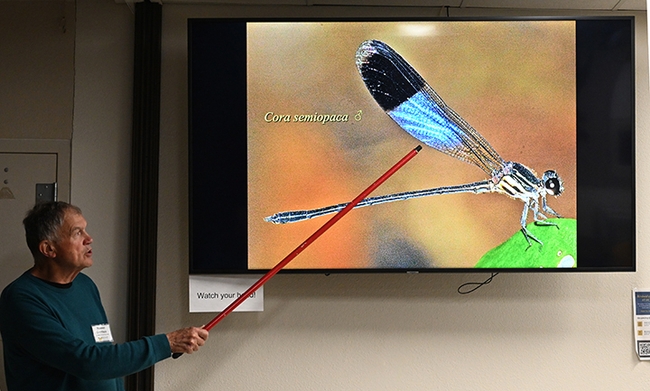
Noted dragonfly expert Rosser Garrison shows a slide of Cora semiopaca at the Bohart Museum of Entomology open house. (Photo by Kathy Keatley Garvey)
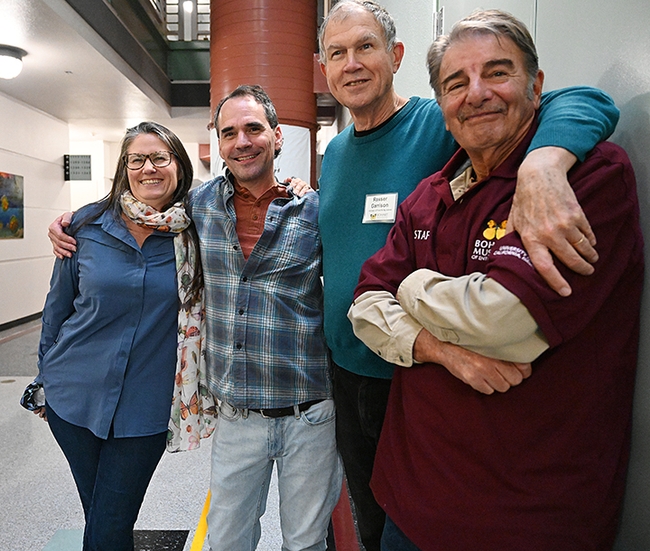
Dragonfly experts at the Bohart Museum open house included Sandra Hunt-von Arb, with the Pacific Northwest Biological Resources Consultants, Inc.; Andy Rehn, stream ecologist with California Department of Fish and Wildlife; Rosser Garrison, formerly with the California Department of Food and Agriculture; and Greg Kareofelas, Bohart associate. (Photo by Kathy Keatley Garvey)
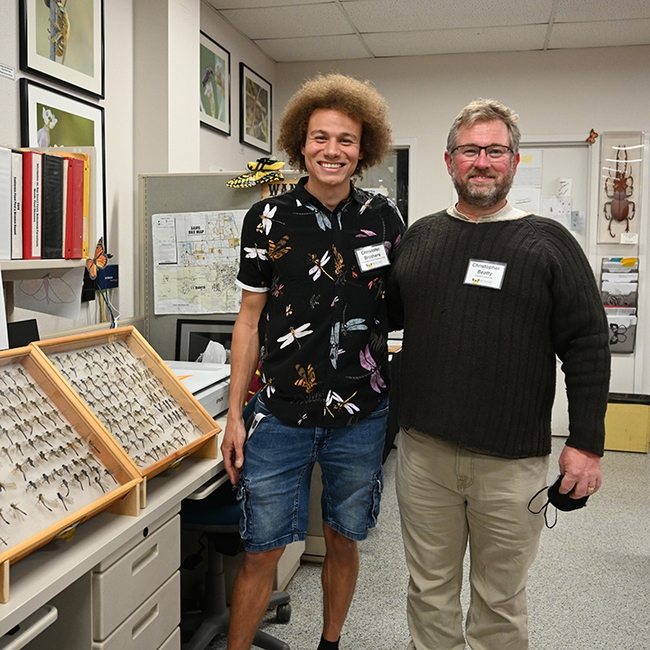
Christofer Brothers (left), a UC Davis doctoral student studying dragonflies, and Christopher Beatty, a visiting visiting scholar in the Program for Conservation Genomics at Stanford University, offered their expertise at the Bohart Museum open house. (Photo by Kathy Keatley Garvey)
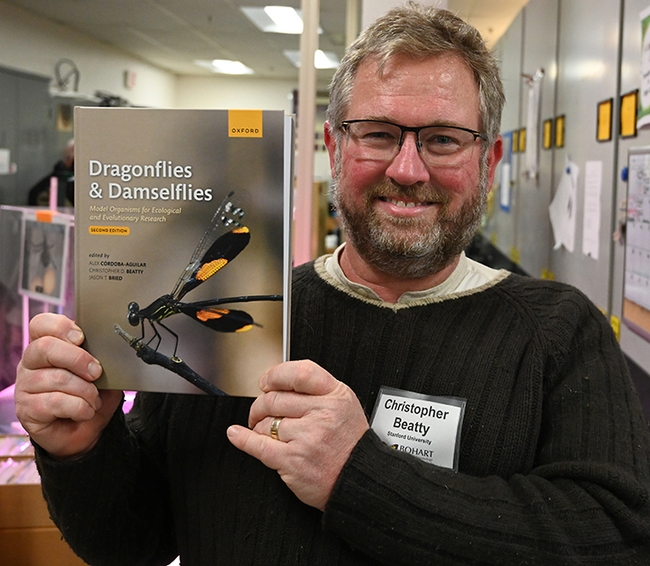
Christopher Beatty, a visiting scholar in the Program for Conservation Genomics at Stanford University, is a co-editor and co-author of this newly published book, "Dragonflies and Damselflies: Model Organisms for Ecological and Evolutionary Research," second edition. Fresh from the printers, it was among the dragonfly books displayed at the open house. (Photo by Kathy Keatley Garvey)
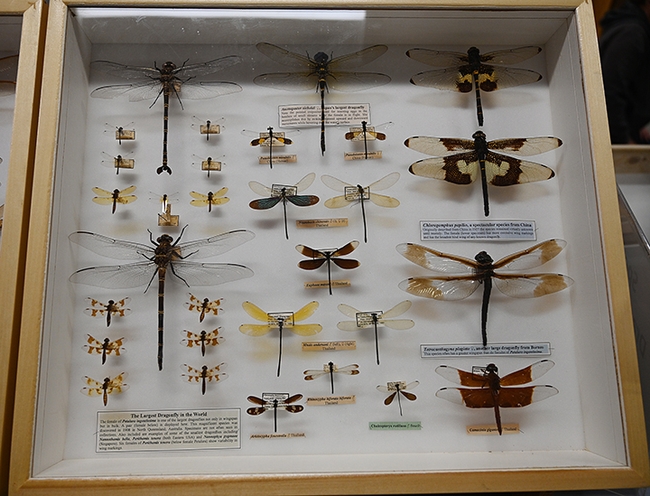
This Bohart Museum display includes the world's largest dragonfly, Petalura ingentissima, discovered in 1908 in North Queensland, Australia. (Photo by Kathy Keatley Garvey)
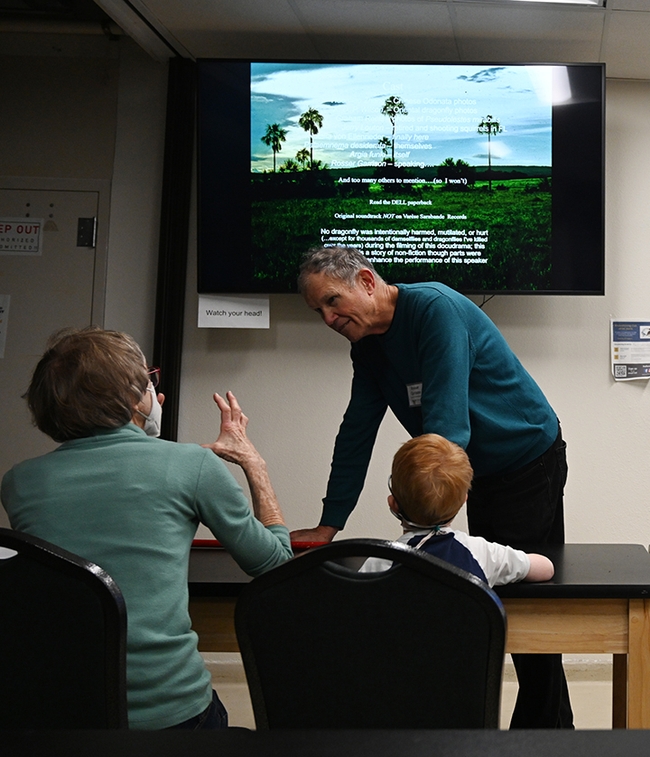
Rosser Garrison answers questions following his seminar on dragonflies. (Photo by Kathy Keatley Garvey)
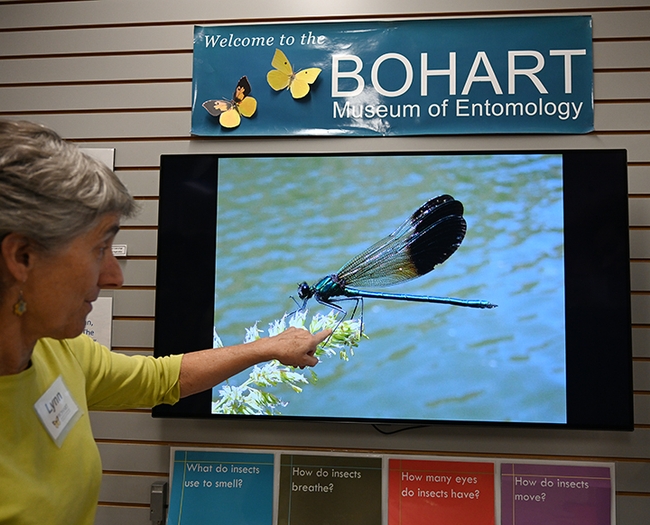
The Bohart Museum showcased dragonfly images by Bohart associate Greg Kareofelas. Here Lynn Kimsey, director of the Bohart, admires a river jewelwing, Calopteryx aequabilis, that Kareofelas photographed at the Klamath River. (Photo by Kathy Keatley Garvey)